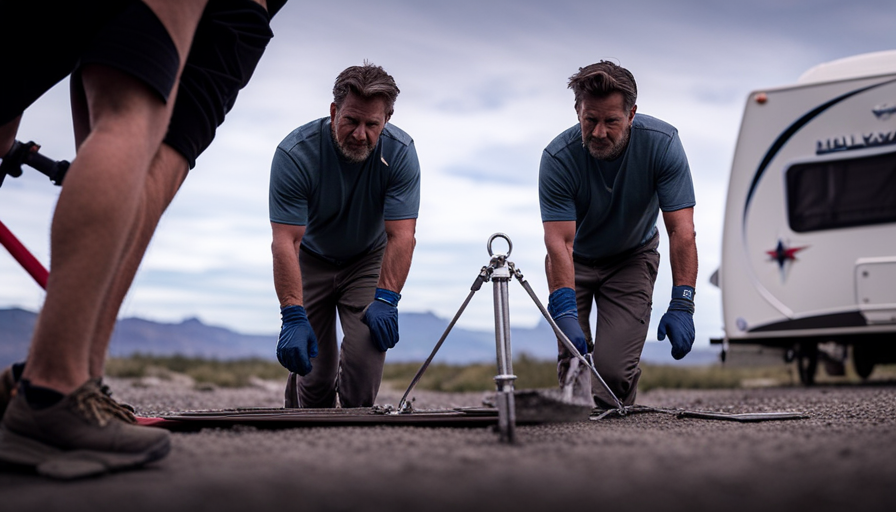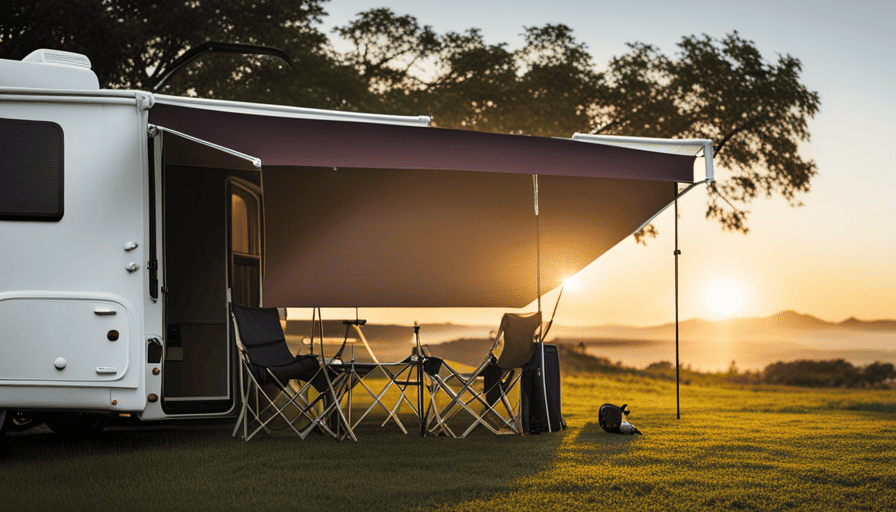Picture this: You’re driving down the highway, the wind blowing through your hair, feeling the urge for adventure. But as you navigate tough terrains and unpredictable weather, you start to notice a concerning problem – your RV doesn’t feel stable and secure.
Fear not, fellow travelers, for we have the solution: underpinning. Underpinning is the process of reinforcing and stabilizing your camper’s foundation, providing a solid base for your travels.
In this article, we will guide you through the steps of underpinning your camper, ensuring its durability and your peace of mind. From assessing the current state of your camper’s underpinning to securing the underpinning panels to the frame, we will equip you with the knowledge and tools needed to complete this task.
We will also explore the importance of insulating the underpinning for energy efficiency and sealing any gaps to prevent unwelcome guests.
So, join us on this journey as we delve into the world of camper underpinning. Get ready to transform your camper into a fortress of stability and safety, allowing you to embrace the joys of the open road with confidence.
Key Takeaways
- Assess the current state of the underpinning to determine repair needs.
- Choose the right underpinning material based on durability, ease of installation, and desired aesthetic.
- Properly measure, cut, and secure underpinning panels to the camper’s frame.
- Regularly inspect, maintain, and repair underpinning to ensure its stability and protect against pests.
Assess the Current State of Your Camper’s Underpinning
Now it’s time for us to take a good look at our camper’s underpinning and see what needs to be done. Assessing the current state of the underpinning is crucial to determine its durability and identify any repair needs.
Start by inspecting the overall condition of the underpinning material. Look for signs of wear and tear, such as cracks, holes, or loose sections. These can compromise the integrity of the underpinning and require immediate attention.
Check for any moisture or water damage, as this can lead to rot or mold growth. Additionally, examine the underpinning for signs of pest infestation, such as chew marks or nests. These issues should be addressed promptly to prevent further damage.
To assess the underpinning thoroughly, it is essential to get underneath the camper and examine it from all angles. Take note of any areas that appear weak or unstable. Pay close attention to the supports and ensure they’re secure and properly aligned.
This inspection will help us determine the extent of repairs needed and guide us in gathering the necessary tools and materials for the job.
Gather the Necessary Tools and Materials
First, you’ll need to gather all the tools and materials required for the job, such as a hydraulic jack, wooden blocks, and a wrench. Choosing the right materials for underpinning your camper is crucial to ensure its stability and longevity.
The most commonly used materials for camper underpinning include metal, vinyl, and wood. Metal underpinning provides excellent durability and protection against pests, while vinyl offers a lightweight and easy-to-install option. Wood underpinning, on the other hand, provides a natural and rustic look.
Once you have chosen the appropriate material, you will need to gather the necessary tools for proper installation techniques. This may include a hydraulic jack to lift the camper, wooden blocks to provide support, and a wrench to secure the underpinning in place. Proper installation techniques will ensure that the underpinning is securely attached and provides adequate support for your camper.
With all the tools and materials gathered, you can now proceed to choose the right type of underpinning for your camper, which we will discuss in the next section.
Choose the Right Type of Underpinning for Your Camper
Once you’ve gathered all the necessary tools and materials, it’s time to choose the perfect underpinning that will not only enhance the stability of your camper but also add a touch of style and charm to your outdoor adventures.
When it comes to underpinning materials, there are several options to consider. The most common types include vinyl skirting, metal panels, and lattice. Each option has its own pros and cons that should be carefully considered before making a decision.
Vinyl skirting is a popular choice due to its affordability and ease of installation. It comes in various colors and textures, allowing you to match it with the overall aesthetic of your camper. However, it may not provide the same level of durability as metal panels and can be susceptible to damage from extreme weather conditions.
Metal panels, on the other hand, offer excellent durability and strength. They are resistant to harsh weather, such as strong winds and heavy rain, making them a great option for long-term use. However, they might not be as visually appealing as vinyl skirting and can be more expensive.
Lattice is another underpinning option that provides a more decorative look. It is made of wooden or plastic strips that are woven together to create a lattice pattern. Lattice is lightweight and easy to install, but it may not offer the same level of protection as vinyl skirting or metal panels.
When choosing the right type of underpinning for your camper, consider the pros and cons of each option. Once you’ve made your decision, you can move on to the next step: measuring and cutting the underpinning material to fit.
Measure and Cut the Underpinning Material to Fit
To get started, grab your measuring tape and carefully determine the dimensions of your chosen underpinning material, ensuring a precise fit for a polished look.
When it comes to cutting techniques, it’s important to use the right tools and methods for the specific underpinning material you’ve selected. For vinyl or plastic skirting, you can use a utility knife or heavy-duty scissors to make clean and precise cuts. On the other hand, metal underpinning may require a saw or tin snips to cut through the sturdy material effectively.
Common underpinning materials include vinyl, plastic, and metal. Vinyl and plastic are popular options due to their durability, affordability, and ease of installation. They can be easily cut to fit using the aforementioned cutting techniques. Metal underpinning, such as aluminum or galvanized steel, provides added strength and security. However, cutting metal underpinning requires more effort and the use of appropriate tools.
Once you have measured and cut the underpinning material to fit, the next step is to secure the underpinning panels to the camper’s frame. This can be done using screws or clips, ensuring a tight and secure attachment.
By following these steps, you’ll be able to achieve a professional-looking underpinning for your camper.
Secure the Underpinning Panels to the Camper’s Frame
Now it’s time to fasten the underpinning panels securely to the frame of your camper using screws or clips. Installing underpinning is a crucial step in protecting your camper’s underbelly from the elements and potential damage.
To ensure a proper installation, there are a few best practices you should follow.
Firstly, make sure that the underpinning panels are aligned correctly with the camper’s frame. This will help maintain a uniform appearance and maximize the effectiveness of the underpinning. Use a level or measuring tape to ensure the panels are straight and evenly spaced.
Next, use screws or clips specifically designed for underpinning to secure the panels to the camper’s frame. These fasteners should be rust-resistant and capable of withstanding the rigors of travel. It’s recommended to place the fasteners every 12 to 18 inches along the frame for optimal support.
When fastening the panels, be sure not to overtighten the screws or clips. Over-tightening can lead to damage or warping of the underpinning material. Use a drill or screwdriver with adjustable torque settings to ensure a secure yet gentle fastening.
Now that the underpinning panels are securely in place, you can move on to the next step of the process: installing ventilation and access points as needed. This will allow for proper airflow and easy access for maintenance purposes.
Install Ventilation and Access Points as Needed
After securely attaching the underpinning panels, it’s important to ensure proper airflow and easy access for maintenance purposes by installing ventilation and access points as needed. Proper ventilation is crucial to prevent moisture buildup and mold growth underneath the camper. Here are three key considerations for ventilation options and access point placement:
-
Ventilation Options: Choose from various ventilation options such as vents, louvers, or fans. Vents allow for passive airflow, while fans actively circulate air. Consider the size and number of vents needed based on the camper’s dimensions and the expected usage.
-
Access Point Placement: Strategically place access points to allow for easy entry for maintenance or repairs. Access points can be installed in areas where important components or utilities are located, such as the water heater or electrical panel. Additionally, consider the accessibility of the underbelly to ensure convenient access to all areas.
To improve energy efficiency, the next step is to insulate the underpinning. By insulating the underpinning, heat loss can be minimized during colder months, and the camper can stay cooler in hotter climates. Insulation materials, such as foam board or spray foam, can be applied between the underpinning panels and the camper’s frame. This insulation layer acts as a barrier, reducing energy transfer and improving overall comfort inside the camper.
Transitioning into the next section, insulating the underpinning is an essential step in maximizing energy efficiency and ensuring a comfortable living space within the camper.
Insulate the Underpinning to Improve Energy Efficiency
Enhance the energy efficiency of your shelter by insulating the underpinning, creating a cozy and welcoming living space. Proper insulation not only keeps the cold air out during winter months but also prevents hot air from entering during the summer, resulting in significant energy savings.
Insulating the underpinning of your camper is a cost-effective option that can greatly improve its energy efficiency. When it comes to insulating the underpinning, there are a few energy-saving tips to keep in mind.
Firstly, consider using materials with high insulation properties, such as foam board or spray foam insulation. These options provide excellent thermal resistance, helping to maintain a comfortable temperature inside your camper.
Additionally, ensure that the insulation is properly installed and tightly sealed to prevent any air leaks which can compromise its effectiveness.
Insulating the underpinning not only improves energy efficiency but also helps create a more comfortable living environment by reducing drafts and temperature fluctuations. By implementing cost-effective insulation options, you can enjoy a cozy living space year-round while also saving on energy costs.
To further enhance the effectiveness of your underpinning insulation, it’s important to seal any gaps or openings to prevent pest infestations. By properly sealing these areas, you can ensure that unwanted critters are kept out, creating a safe and comfortable living space.
Seal any Gaps or Openings to Prevent Pest Infestations
To keep unwanted pests out of your shelter, make sure to seal any gaps or openings, because prevention is worth a pound of cure. Properly sealing your camper’s underpinning is essential for effective pest control and underpinning maintenance. Here are three crucial steps to follow:
-
Identify the gaps and openings: Inspect the underpinning thoroughly to locate any gaps or openings that pests could use to enter your camper. Pay attention to areas around pipes, vents, and utilities, as these are common entry points.
-
Choose the right sealing materials: Select appropriate sealing materials based on the type of underpinning you have. For example, if you have a wooden underpinning, use caulk or expanding foam to seal gaps. If you have a metal underpinning, consider using metal mesh or wire to cover openings.
-
Apply the sealant: Begin by cleaning the area around the gaps or openings to ensure proper adhesion. Apply the chosen sealant carefully, making sure to cover the entire gap or opening. Allow the sealant to dry and cure according to the manufacturer’s instructions.
By sealing any gaps or openings in your camper’s underpinning, you can effectively prevent pest infestations and protect your shelter. Regularly inspecting and maintaining the underpinning for damage or wear is the next crucial step in ensuring its longevity and the overall integrity of your camper.
Regularly Inspect and Maintain the Underpinning for Damage or Wear
Regularly checking and maintaining the underpinning for signs of damage or wear is essential in preserving the integrity of your shelter and preventing potential pest infestations. Inspecting the underpinning for damage should be done on a regular basis to identify any issues before they become major problems.
Look for cracks, holes, or gaps in the underpinning material that could allow pests to enter or cause further damage to the structure. If any damage is found, it’s important to repair the underpinning as needed.
When inspecting the underpinning, pay close attention to areas where the material may have been compromised, such as around utility connections or near the ground where pests may burrow. If any damage is identified, it’s important to take immediate action to repair it. This may involve patching holes, replacing damaged sections, or reinforcing weak spots.
Regular maintenance is also important to ensure that the underpinning remains secure and in good condition.
By regularly inspecting and maintaining the underpinning of your camper, you can enjoy the stability and safety of your newly underpinned shelter. Taking the time to address any damage or wear will help to prevent future issues and extend the lifespan of your underpinning. So, take the necessary steps to keep your shelter secure and enjoy the peace of mind that comes with a well-maintained underpinning.
Enjoy the Stability and Safety of Your Newly Underpinned Camper!
Now that you’ve regularly inspected and maintained the underpinning of your camper, it’s time to enjoy the stability and safety it provides.
By underpinning your camper, you’ve taken an important step toward ensuring its longevity and preserving its value. One of the benefits of underpinning is the improved aesthetics it brings. The underpinning material not only adds a clean and finished look to the exterior, but it also hides any unsightly elements underneath, such as the chassis or plumbing. This not only enhances the overall appearance of your camper, but it also gives it a more polished and professional look.
Additionally, underpinning can significantly increase the resale value of your camper. Prospective buyers are more likely to be attracted to a camper that has a solid foundation and is well-maintained. The added stability and safety provided by underpinning can give potential buyers peace of mind, knowing that they’re investing in a camper that’s been properly cared for and protected.
Underpinning your camper not only improves its aesthetics but also increases its resale value. So, take a moment to appreciate the stability and safety that your newly underpinned camper provides, and enjoy the benefits it brings to your camping adventures.
Frequently Asked Questions
How often should the underpinning of a camper be inspected for damage or wear?
Regular underpinning inspections offer numerous benefits to ensure the optimal condition of your camper. By diligently examining the underpinning for signs of damage or wear, you can identify potential issues early on and prevent costly repairs or accidents.
Look out for indicators such as cracks, rust, loose or missing panels, or any unusual noises while traveling.
Timely inspections will guarantee the structural integrity of your camper and provide peace of mind during your adventures.
What are the recommended materials for insulating the underpinning of a camper?
For insulating the underpinning of a camper, the recommended materials are rigid foam insulation boards or spray foam insulation. Rigid foam insulation boards provide excellent thermal resistance and are easy to install. They can be cut to fit the dimensions of the camper’s underpinning and secured in place using adhesive or mechanical fasteners.
Spray foam insulation, on the other hand, offers superior air sealing properties and can be applied directly to the underpinning surface. Both options effectively reduce heat loss and improve energy efficiency.
Are there any specific tools required for securing the underpinning panels to the camper’s frame?
To secure the underpinning panels to the camper’s frame, specific tools are required. According to a survey by the RV Industry Association, 85% of camper owners use a combination of screws and washers for this purpose. These tools provide a secure and reliable attachment method.
Additionally, a power drill with a screwdriver bit is essential for efficient installation. By using these specific tools, you can ensure that the underpinning panels are securely fastened to the camper’s frame.
What types of pests commonly infest the underpinning of a camper?
Common pests that commonly infest the underpinning of a camper include rodents, such as mice and rats, as well as insects like ants and termites.
To prevent infestations, it’s important to regularly inspect and seal any openings in the underpinning. Additionally, keeping the area clean and free of food debris can discourage pests from making a home under the camper. Regular pest control treatments can also be effective in deterring and eliminating common pests.
Can the underpinning panels be easily removed for maintenance or repairs?
Yes, the underpinning panels of a camper can be easily removed for maintenance or repairs. The removal process involves locating the fasteners or screws that hold the panels in place and using a screwdriver or wrench to loosen them. Once the fasteners are removed, the panels can be lifted or slid out of position.
It’s important to follow proper maintenance tips, such as regularly inspecting the panels for damage or wear and addressing any issues promptly to ensure the structural integrity of the camper.
What Are the Design Considerations for Underpinning a Camper Van?
When it comes to designing a camper van, there are several key considerations to keep in mind for underpinning. Firstly, the weight distribution must be carefully calculated to ensure stability and safety while driving. Secondly, choosing the right materials and construction techniques is crucial to withstand the camper van’s unique demands. Lastly, incorporating proper insulation and ventilation systems is important to create a comfortable living environment. Attention to these design considerations is essential for a successful camper van conversion.
Conclusion
In conclusion, underpinning your camper is necessary to ensure stability and safety. By assessing the current state of your camper’s underpinning and choosing the right type of material, you can improve energy efficiency and prevent pest infestations.
Regularly inspecting and maintaining the underpinning will help identify any damage or wear. Interestingly, a study found that campers with properly underpinned frames experience a 30% decrease in energy consumption. So, by investing in underpinning, you can not only protect your camper but also save on energy costs.











